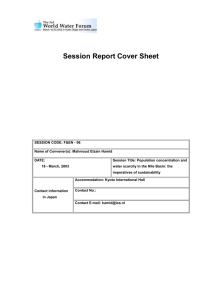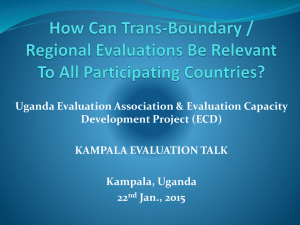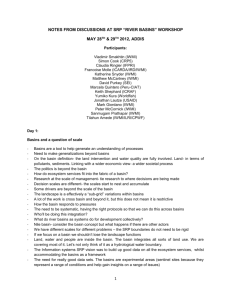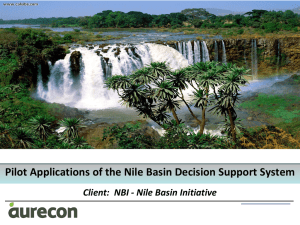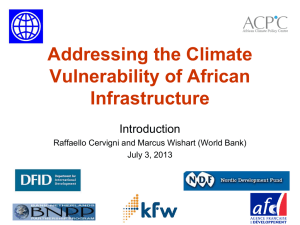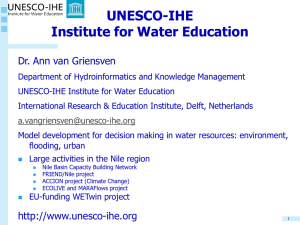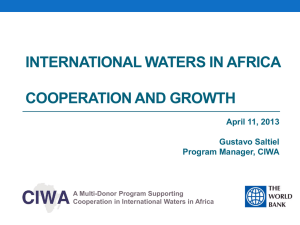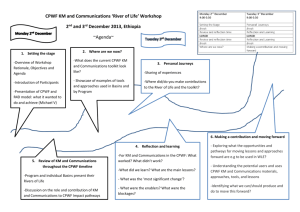BASIN BOOKS - Water, Land and Ecosystems
advertisement
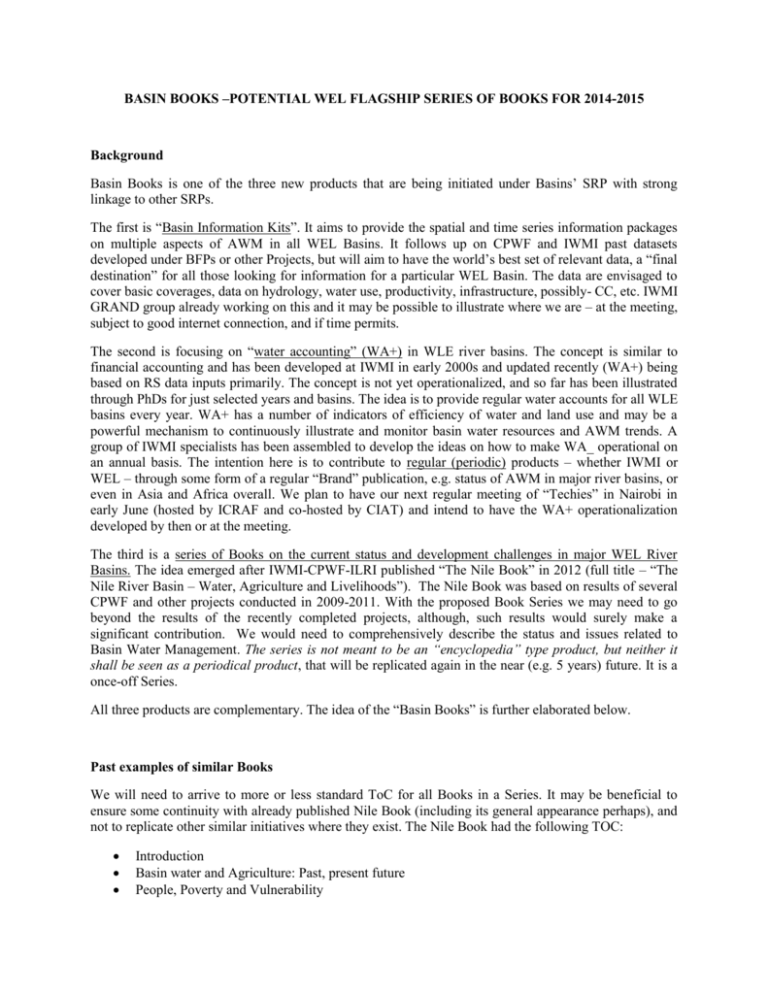
BASIN BOOKS –POTENTIAL WEL FLAGSHIP SERIES OF BOOKS FOR 2014-2015 Background Basin Books is one of the three new products that are being initiated under Basins’ SRP with strong linkage to other SRPs. The first is “Basin Information Kits”. It aims to provide the spatial and time series information packages on multiple aspects of AWM in all WEL Basins. It follows up on CPWF and IWMI past datasets developed under BFPs or other Projects, but will aim to have the world’s best set of relevant data, a “final destination” for all those looking for information for a particular WEL Basin. The data are envisaged to cover basic coverages, data on hydrology, water use, productivity, infrastructure, possibly- CC, etc. IWMI GRAND group already working on this and it may be possible to illustrate where we are – at the meeting, subject to good internet connection, and if time permits. The second is focusing on “water accounting” (WA+) in WLE river basins. The concept is similar to financial accounting and has been developed at IWMI in early 2000s and updated recently (WA+) being based on RS data inputs primarily. The concept is not yet operationalized, and so far has been illustrated through PhDs for just selected years and basins. The idea is to provide regular water accounts for all WLE basins every year. WA+ has a number of indicators of efficiency of water and land use and may be a powerful mechanism to continuously illustrate and monitor basin water resources and AWM trends. A group of IWMI specialists has been assembled to develop the ideas on how to make WA_ operational on an annual basis. The intention here is to contribute to regular (periodic) products – whether IWMI or WEL – through some form of a regular “Brand” publication, e.g. status of AWM in major river basins, or even in Asia and Africa overall. We plan to have our next regular meeting of “Techies” in Nairobi in early June (hosted by ICRAF and co-hosted by CIAT) and intend to have the WA+ operationalization developed by then or at the meeting. The third is a series of Books on the current status and development challenges in major WEL River Basins. The idea emerged after IWMI-CPWF-ILRI published “The Nile Book” in 2012 (full title – “The Nile River Basin – Water, Agriculture and Livelihoods”). The Nile Book was based on results of several CPWF and other projects conducted in 2009-2011. With the proposed Book Series we may need to go beyond the results of the recently completed projects, although, such results would surely make a significant contribution. We would need to comprehensively describe the status and issues related to Basin Water Management. The series is not meant to be an “encyclopedia” type product, but neither it shall be seen as a periodical product, that will be replicated again in the near (e.g. 5 years) future. It is a once-off Series. All three products are complementary. The idea of the “Basin Books” is further elaborated below. Past examples of similar Books We will need to arrive to more or less standard ToC for all Books in a Series. It may be beneficial to ensure some continuity with already published Nile Book (including its general appearance perhaps), and not to replicate other similar initiatives where they exist. The Nile Book had the following TOC: Introduction Basin water and Agriculture: Past, present future People, Poverty and Vulnerability Spatial Characterization for improved Basin Management Availability of water for agriculture Hydrological Processes- how water flows Soil erosion, sediment loss and degradation Basin farming systems and productivity Livestock and Water Groundwater Wetlands, contribution to livelihoods Basin water governance Institutions and Policies Simulating current and future water resources development in the Basin Water management intervention analysis The above can serve as a starting point for refined ToC discussion of future Books. It is possible that Books for individual Basins will have Basin-specific chapters. Another example: the NBI started to produce “The state of the River Nile Basin” series. The first printed in 2012. They intend to replicate it every 3 years. It is suggested that we partner with NBI for 2015 production, although this will not be part of the suggested Book Series. The ToC of NBI series is: Introduction The water resources of the Nile (all processes, quality, availability, trans-boundary issues) The environmental Resources of the Nile (eco-regions, fauna, degradation etc) Opportunities and challenges of the growing population Agriculture, food security and livelihoods (agro-systems, production, trade) Hydropower Water Transport Climate Change and implications Summary – state 2012 Annexes – indicators and sources. A Table of indicators is given for each of the Chapters above. A few more indicators suggested to be used in the future As can be seen from above, this content is wider than that of the Nile Book. Presumably there is a similar series produced for Mekong by MRC. If yes, we shall partner similarly on this with MRC. If not – we suggest to MRC to produce such Book for Mekong together. Process It is suggested that we focus on the following Basins first: Volta Zambezi Indus Ganges Aral Sea Basin (Syr Darya and Amu Darya, possibly in one Book) The rational is that the above Basins are unlikely to have such Books at present, they are all WEL Basins, and for all of them significant CPWF, IWMI and other partners’ recent research is available. After finalizing the draft ToC, we will identify Chapter leaders and approach them. People can be selected from within CG and beyond. In cases when external partners are chosen to contribute chapters, they will need to be paid consulting fees. In case of internal writers – it is staff time that will have to be allocated. It is suggested here that the Books are seen as a cross-SRP initiative and are funded from WEL Competitive Fund, at least to a degree. It may be worth having at least one or two same main Editor(s) for all Books (for consistency, although not critical, and in fact, may not be possible), with additional “Basin –specific” Editors added for each individual Book. Alternative is to identify a Leader for production of each Book, and have “Basin Books” as a normal project with an overall PL. Judging by the experience of the Nile Book, it takes about 1 year from the moment of initiating the Chapters (assuming that those are “pre-cooked”, results available etc) to actual release of the Book by the Publisher. If the idea is approved in principle, we shall: Fine tune the ToC and funding mechanism Identify Book Leading Editors and Contributors Make a formal proposal to Earthscan who expressed big interest in publishing the Series Start the production of Books no later than September 2013 to ensure delivery by end of 2015 The approximate production schedule (ambitious) may look like this: 2013 Q3 Q4 2014 2015 Q1 Q2 Q3 Q4 Q1 Q2 Q3 Volta Book Zambezi Book Indus Book Ganges Book Aral Sea Basin Book Q4 Budget A draft Budget below is given based on the Nile Book Budget, with some additional anticipated expenses. A number of copies is fixed for now, but we can revise this depending on how wide we want to distribute the books and on Budget available. Publisher (600 copies) USD 35,000 Staff time, Senior Editors 40days @ USD 850 USD 35,000 Other Staff time, or Consultants, 100 days @ USD 500 USD 50,000 Contingencies USD 30,000 Total USD 150,000 The estimated cost of production thus comes to approximately $150K per Book, or at least it is the intention to keep it at that. But individual Books may have different Budgets. Comments and suggestions welcome.
